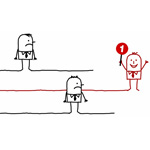In this article, TBH club member Ian Pickett gives a very valuable insight into shaving those all important seconds off your race time.
Want to take 10 seconds off your 5k with no extra training?
As an unlucky few of you will know (those I have bored), I have recently completed my qualification to become a course measurer. This means I am now able to measure races to confirm them as official distances for the purposes of UK Athletics.
I won’t go in to the detail of how a course is measured, maybe something for the future! But, I thought it was worth mentioning something that most of us could make use of and something that I have been putting in to practice myself.
Courses are measured along the shortest possible route (SPR). This is the line that a runner could take that would be the absolute shortest path. This includes over pavements, grass verges etc.
Here’s a couple of SPRs for different road layouts:

The photos below show three different lines that runners have taken in a race. If there are no barriers or marshals then the SPR would be across the pavement as per the last picture! The elite runners are covering a significant extra distance getting around this bend.

If there had been barriers to prevent runners using the pavement, and the route had followed the road, as in the first picture, the difference between turning exactly on the bend versus running 2m from the edge is more than 3m. (Notice the gap between the runners on the middle picture and you’ll appreciate how frequently we all take turns with much bigger sweeps than 2m).
It might not sound too much but you don’t need many lazy bends like this to quickly add on some very precious time.
Take, for example, the Newcastle parkrun course. The last time I ran it there were 11 significant bends. If each of these had been a lazy 2m turn then this would have added an extra 35 metres over the length of the course. It doesn’t sound much but that’s an extra 11 seconds for someone who is running a 25 minute 5k. That’s 11 seconds gained for nothing more than a bit of concentration.
This is something I focused on during the GNR. With huge dual carriageways and thousands of runners it was possible to run very, very lazy bends. The accumulation of this extra distance quickly adds up and it would be possible to add hundreds of extra metres and minutes to your time over a half-marathon or marathon course.
It wasn’t easy sticking to the SPR and at times I wondered where the measurers would actually have taken the line, I’m pretty certain Mo didn’t stick to it, but I’m confident that I reduced my time a little by concentrating on this.
Good luck.
Ian Pickett


5 Responses
great article Ian .. thanks for taking the time to submit this.
Very interesting and very useful article Ian. Thanks.
Interesting article. I’ve often wondered what the “rules” are as regards pavements, verges, etc. Presumably you can run where you want, as long as there is no tape or barrier? So, at the beginning of the Blaydon Race, for example, there’s nothing wrong with going on the pavement (where there are often spectators) to avoid overcrowding on the course, and indeed to take the SPR? I remember during the Liverpool Half Marathon there were opportunities to “cut corners” by using pavements, but few took up this option – probably worried it was illegal…
Thanks for the comments.
Simon – you’re right. When the course is measured, the measurer should stand at these points and ask the race organiser whether they will prevent runners taking the direct route, if the response is that they won’t, then the measurer should take the line open to the runner. An example of this is the right hand turn on the Newcastle ParkRun (note this isn’t actually a certificated course!) from the Moor on to Grandstand road. The path takes you around a little cabinet but you can take a shortcut in front of it. The “honest” runner may think they should stick to the path but if I was measuring this I would take the “short cut”. But don’t blame me if you get runners shouting at you for taking shortcuts!!
Great article, thanks Ian. Who knew! I’ll keep that in mind for my race. Every little helps